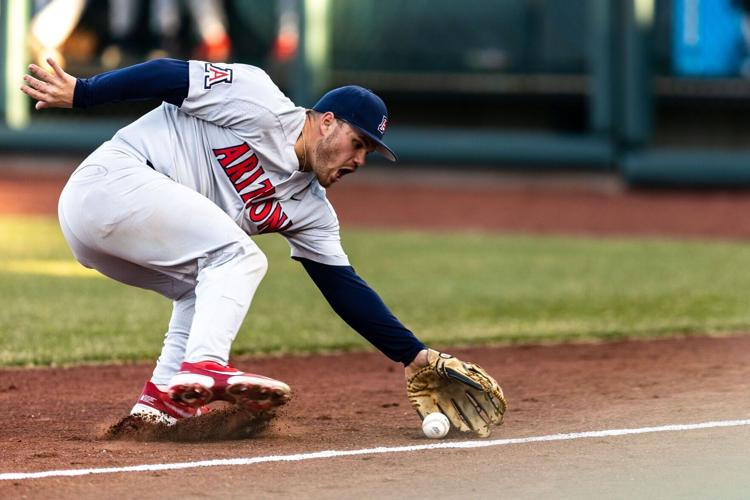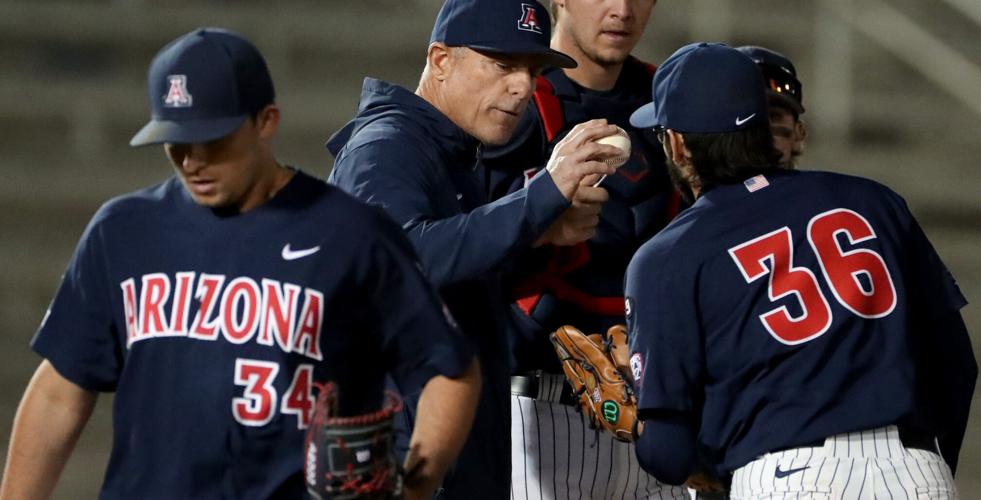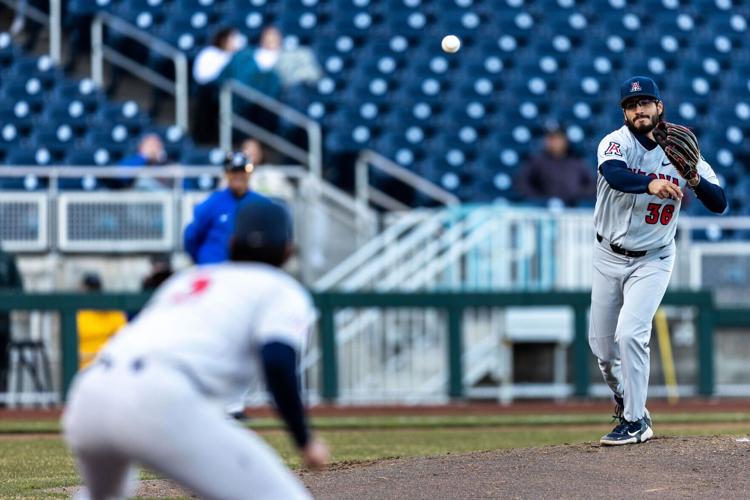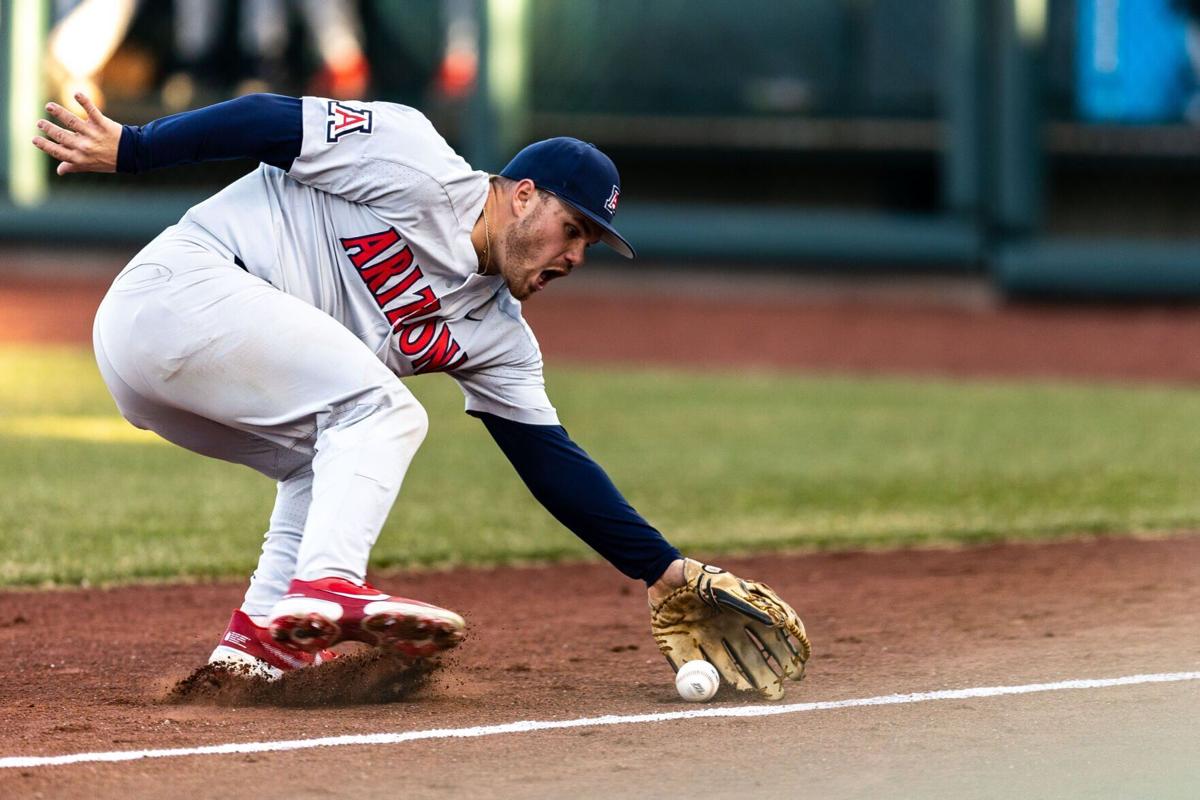When Arizona lost the final two games of its series at Utah last weekend, it felt as if the Wildcats’ once-promising season was on the verge of collapse.
Arizona had dropped its second consecutive Pac-12 series to one of the league’s lower-level programs (at least by record), and a team once in line to host an NCAA regional fell out of the Top 25.
The Wildcats then faced a two-game set at Creighton, knowing full well that a series against rival Arizona State was looming. It was windy and cold in eastern Nebraska, and most of the seats at Charles Schwab Field Omaha were empty. Atmospherically, it was about as far from the College World Series as you could get.
But Chip Hale’s club played with purpose and urgency, sweeping the Bluejays and returning to Tucson with a 3-2 record on the road trip. Arizona climbed in the RPI rankings from the upper 40s to No. 31 after sweeping a team that owned the nation’s longest home winning streak (14 games).
How did the Wildcats get it done? Where did things go wrong in Salt Lake City? Here are five takeaways from Arizona’s five-game road trip as the Wildcats (26-12, 11-7 Pac-12) gear up for this weekend’s clash with the Sun Devils (19-19, 8-7) at Hi Corbett Field:

Arizona oach Chip Hale hands the ball from starter Anthony Susac to George Arias Jr. during the team’s March 8 game against New Mexico. Arias, a Tucson High graduate and son of former UA and big-league standout George Arias, has been lights-out coming out of the bullpen this season.
The ’pen is mightier
With five games in six days – and starter Dawson Netz dealing with an arm issue – Hale and pitching coach Dave Lawn decided to hand the ball to the bullpen for both games in Omaha.
The relief corps came through in a big way. Eight UA pitchers limited Creighton to one run in two games as Arizona notched 6-0 and 3-1 victories Monday and Tuesday. The Wildcats hadn’t limited the opposition to one run over two games since the first two contests of the 2018 season.
Left-hander Holden Christian, Arizona’s closer for much of the season, started both games and was the only pitcher to surrender a run. Christian, Anthony Susac and George Arias Jr. each pitched three innings in Omaha. Susac and Arias picked up the wins.
Quinn Flanagan and Trevor Long continued their stellar work as the Wildcats’ eighth- and ninth-inning options. The right-handers combined to allow just two hits and one walk in 4 1/3 innings. They also finished the lone win at Utah with 2 2/3 scoreless frames, helping Arizona hang onto a one-run lead.
Long ranks first on the team with a 0.79 ERA and a 0.88 WHIP. Flanagan ranks second in both categories (1.45, 1.10).
Although the staff walked too many batters (nine) Tuesday – in part because of an inconsistent strike zone – it allowed just four hits. Arizona posted a 1.27 WHIP against Creighton – a vast improvement over the previous series.

Arizona reliever George Arias Jr. throws to first base during Monday’s win over Creighton at Charles Schwab Field.
Struggling starters
Starting pitching wasn’t the only reason the Wildcats lost their series in Salt Lake City, but it was unquestionably a driving force.
TJ Nichols, Garrett Irvin and Chandler Murphy combined for a 12.75 ERA against Utah, yielding 17 earned runs in 12 innings. Their collective WHIP was 2.50.
Nichols struggled for the second consecutive outing. The right-hander lasted just three innings on April 8 against Washington State. His ERA has climbed from 2.34 to 4.18.
Nichols has allowed 18 hits in his past 9 1/3 innings after yielding only 34 in his first 42 1/3. Is the sophomore getting fatigued? Have opponents figured him out? It’s hard to say. Worth noting, though: Fifteen of those 18 hits allowed were singles. The other three were doubles.
Nichols hasn’t allowed a home run in his past four outings. Utah hit only one homer in the series, a solo shot off Susac in Game 2. The Utes primarily relied on small ball and did a superb job of putting the ball in play. Thirty-one of their 41 hits were singles. Eight were doubles.
Irvin was the most effective of the three weekend starters, but he wasn’t sharp either. He was removed from Friday’s game after yielding three runs on four hits in three innings. Irvin had thrown 69 pitches at that point.
Murphy followed up his best outing with his worst. After throwing five scoreless innings against WSU, Murphy couldn’t get out of the third vs. Utah. He was charged with eight runs on seven hits.
Clutch? Not much
It’s hard to win when your starting pitchers are scuffling. The Wildcats averaged 5.3 runs per game against the Utes — enough, in theory, to take two out of three.
But Arizona’s offense had plenty of opportunities to turn the tide against Utah and couldn’t come through. The Utes outperformed the Wildcats in most “clutch” categories.
In two-out situations, Utah batted .400 (14 of 35). Arizona hit .306 (11 of 36). That led to a 13-4 advantage for the Utes in two-out RBIs.
Utah also batted .400 with runners on base (24 of 60). Arizona hit just .250 (13 of 52).
The difference was even more pronounced with runners in scoring position. Utah batted .405 in those scenarios (15 of 37). Arizona hit .167 (5 of 30).
Utah also produced way more often with a runner on third base and less than two outs. The Utes got the run home 10 of 13 times (76.9%). The Wildcats succeed just three of 11 times (27.3%).
In short: Utah’s hitters and pitchers executed better than Arizona’s in high-leverage situations.
Hits and runs were hard to come by at Creighton. But when they got a runner to third base with less than two outs, the Wildcats were able to cash in more often than not — succeeding in five of six opportunities (83.3%).
Meanwhile, Arizona’s pitchers performed exceptionally when Creighton put runners in scoring position. The Bluejays didn’t have a single hit in 15 such at-bats.
Bullish on Bullard
Third baseman Tony Bullard was Arizona’s most impactful offensive player at Creighton — a description that hasn’t been applicable for most of this season.
Bullard’s solo home run in the seventh inning of Monday’s game broke a scoreless tie. On Tuesday, he had a pair of singles — one that saw him take a down-and-away breaking ball to right field, the other a hard grounder through the left side that squared the score at 1-1 in the sixth. Bullard later scored on a wild pitch.
Bullard — who missed the start of the season because of a shoulder injury, which followed the death of his father in January — is hitting just .187. But he hasn’t struck out in his past four games, a span of 17 at-bats, after fanning 23 times in his first 58 at-bats.
If Bullard can get on a hot streak that remotely resembles last May/June, it would provide the UA lineup with a massive boost.
Glove story
It wasn’t all bad in Utah. The Wildcats played excellent defense. They didn’t commit a single error in the series. The pitching staff averaged 3.33 walks per game. The Utes had to earn their runs.
Starting with the New Mexico State game that preceded that series and concluding with the first game against Creighton, Arizona went five straight contests without being charged with an error. The Wildcats hadn’t posted a streak that long since 2015. They hadn’t put together four consecutive error-less games since the aforementioned opening stretch in 2018 (when they allowed a total of three runs).
Since a three-error performance in a 6-5 loss to WSU on April 9, Arizona has been charged with only two errors in seven games. The Wildcats are no longer last in the Pac-12 in fielding percentage, and they’ve turned the third-most double plays (32) in the league.
Arizona’s recent rough patch, if you want to call it that, began with an error. The Wildcats were leading the Sun Devils 6-3 with two outs and a runner on base in the bottom of the fifth inning of a non-conference game in Tempe on April 5. A fielding miscue on a play that should have been the third out led to four unearned runs and an eventual 10-6 ASU victory.
Starting with that game, Arizona is 5-5 in its past 10 contests. ASU got swept at Stanford but has won its past five games, outscoring its opponents 58-24.







